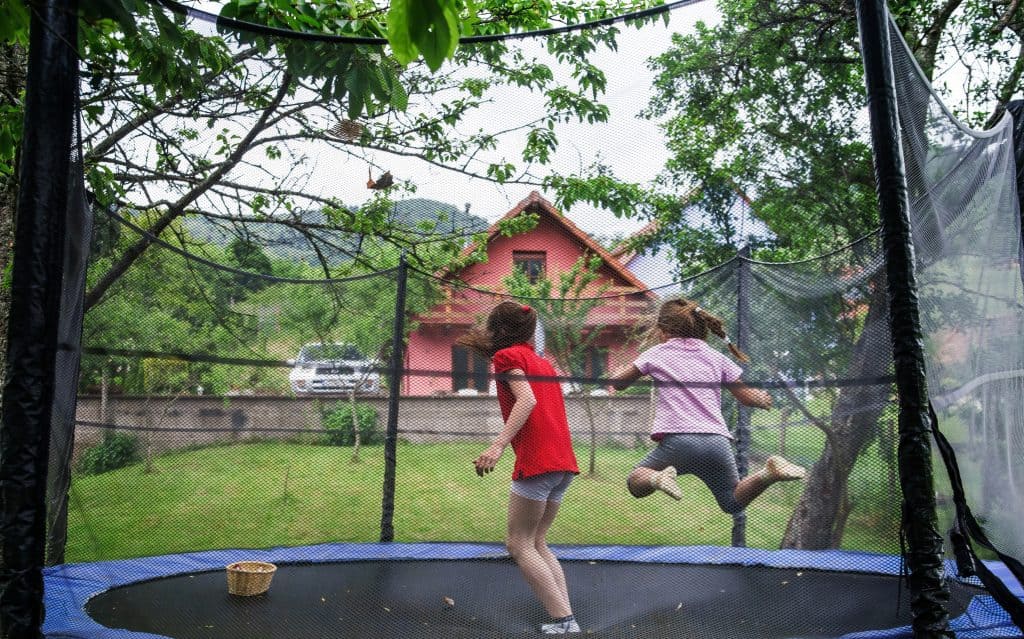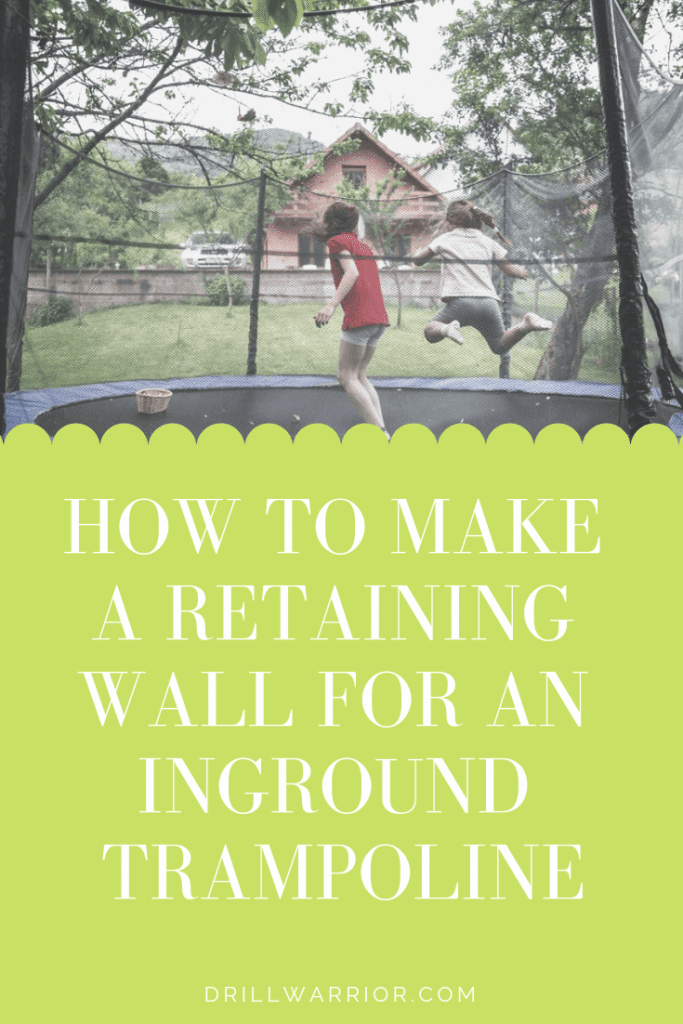
Making a retaining wall for an in-ground trampoline is completely possible on your own. Retaining walls are very important for in-ground trampolines and can be a tricky thing to perfect.
How do you make a retaining wall for an in-ground trampoline? The best materials to use include metal instead of wood. The wood can easily give way under the weight of the dirt and will add extra cost to you. A good choice would be to secure metal sheets around the legs of your trampoline. Some people use concrete blocks to create their retaining wall.
The retaining wall for your trampoline is very important. If you don’t take the time to do it right the first time, you will end up with a lot of headache and payments to deal with. Skip the mistakes, and let us help you create a great retaining wall! – A Great Trampoline Example: ORCC Trampoline
The Perfect Retaining Wall
Trampolines have been a source of joy, excitement, and exercise for a lot of children since they hit the markets. There is nothing quite like those exhilerating moments where you feel like you’re flying!
Parents sometimes have reservations about trampolines because they can be the cause of many injuries for their kids. Safety nets are a good solution, but people have also opted for putting their trampoline into the ground.
This tactic is also a way to make your backyard more attractive and can protect you from having to chase your trampoline down the road if ever there are strong winds. The issue is that an in-ground trampoline creates a bit more work for you.
Once you decide to take on this feat, you will need to know how to do it and what elements are involved to be successful. This is where we come in! I’m here to give you tips, tricks, and pointers to help you create the best retaining walls for your family’s in-ground trampoline.
Retaining walls are important because they help keep the ground where you want it. You never want to come outside to see that the dirt walls surrounding your in-ground trampoline have suddenly collapsed beneath it. This can ruin your yard and your kids’ good time.
You don’t want dirt caving under your trampoline for many reasons, but the most important (in your kids’ eyes at least) is that it’s impossible to jump. It can also be very dangerous and messy. Let’s just skip the land sliding part and jump to having a good time!
The great thing about a solid retaining wall is that, if a rain storm hits and dampens the ground to the point of instability, you won’t have to worry about precarious dirt collapsing from the wetness.
When creating your retaining wall, you will need to decide if you want it to be attached to your trampoline or be a part of the actual gaping hole the trampoline will sit in. This decision will change how you go about this task.
The use of metal to complete this task is encouraged. Metal is stable, durable, and strong. Wood can be used to create a retaining wall but is more susceptible to collapse under the pressure of the land. Metal is a better choice.
What you want to remember when creating the retaining wall is to build the hole and wall so that the trampoline can sit a touch above the ground to allow airflow. Jumping on a trampoline gets significantly harder when little airflow is present to aid in your bouncing.
You also want to insure that your retaining wall is well finished so that there is little risk of injury when it’s completed.
Wrapping the Trampoline
I have seen a lot of people choose to wrap their trampoline legs in sheet metal to create the perfect retaining wall.
The tactic that one family used was to bolt 2x4s into the legs of your trampoline as an anchor and then attach the correct length of sheet metal to them with screws.
When bolting the wood to the trampoline you probably want to have pre-drilled holes to make your life easier and the project more successful.
It’s very important to fold over and rol your sheet metal at the tops when you’re done. Unfolded sheet metal can become a very serious hazard because someone could easily misstep and cut their foot.
Safety first! Don’t leave the sheet metal as is.
A good way to do this is to leave a few inches of sheet metal to stick out over your 2x4s. After attaching it all, fold the extra bits of sheet metal on top over the 2x4s and screw them into the other side. This really keeps away any chance of cut feet or hands.
Building the Retaining Wall Into the Sides of the Pit
Another option when creating your retaining wall is to line your pre-dug hole with cinder blocks, metal rims, bricks, or wood.
Again, wood is not the best choice because it isn’t as stable or as strong as other options.
You want to make sure your ground is level at all times to make the entire project more successful. Layering cinder blocks is a popular option because they are durable. They can stand the test of time and put up a good fight against caving dirt.
You always want to make sure all your measurements are correct before putting permanent (or semi-permanent) retaining wall materials in place. Try laying out your materials where they will stand and then lowering the trampoline in to see how it fits. Adjust as necessary.
After you are sure of your measurements, you can safely begin creating a strong retaining wall. You’ll want to have enough adhesive materials, like concrete, to accomplish your task. No dirt is going to mess with a strong ring of cinder blocks.
Use your imagination but also your brain. You can create a great retaining wall out of any sturdy material. You always want to make sure that there is nothing involved that can rot from rain water or would attract insects or rodents.
There is always going to be the possibility that water will get under the trampoline, but with a good drainage system, you won’t have to worry about water puddling for too long. You’ll want to have your retaining wall built to a point where you can still access the bottom of the trampoline if you ever have problems.
No matter what you decide to do for your in-ground trampoline retaining wall, you want to be certain that the materials are covered enough to keep your family safe. There’s nothing worse than unexpectedly hitting a sharp piece of metal or hard concrete when you’re trying to enjoy your trampoline.
A tip for keeping your family safe is to stick something, like re-purposed pool noodles, right under the lip of the trampoline. This can help keep things from falling underneath the trampoline, continue allowing ample airflow, and protect kids from falling through or stepping on something they shouldn’t.
There doesn’t really seem to be a number one best solution to the retaining wall problem, but the metal siding is a good way to go. It is easy, simple, and stable. If you’re leaning more towards the cinder block, brick, or metal ring options, make sure everything is level and measured out correctly.
You’ll be glad you took the time to create a good and strong retaining wall once the project is completed. Your hard work will show in the practicality, functionality, and attractiveness of your new in-ground trampoline! Your kids will love it and so will you!
Happy jumping!
Related Questions
How deep should a trampoline be in the ground? You want the depth of your hole to be a couple inches shorter than the lip of your trampoline. Doing this allows air to flow beneath the trampoline which makes a better jumping experience. The actual size will differ depending on your individual trampoline.
Are in-ground trampolines safer? In-ground trampolines are viewed as safer than their above-ground counterparts. The truth is that you can get hurt on a trampoline anywhere if you don’t have a safety net or try extreme tricks. They are closer to the ground but you can still be injured if you don’t take proper precautions.


